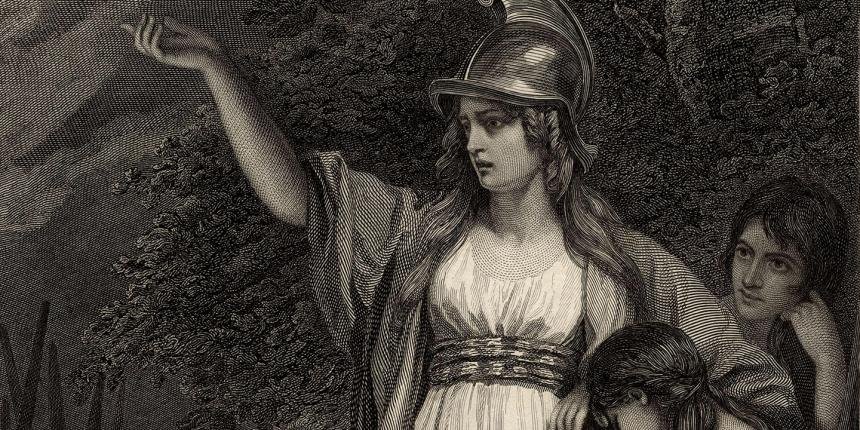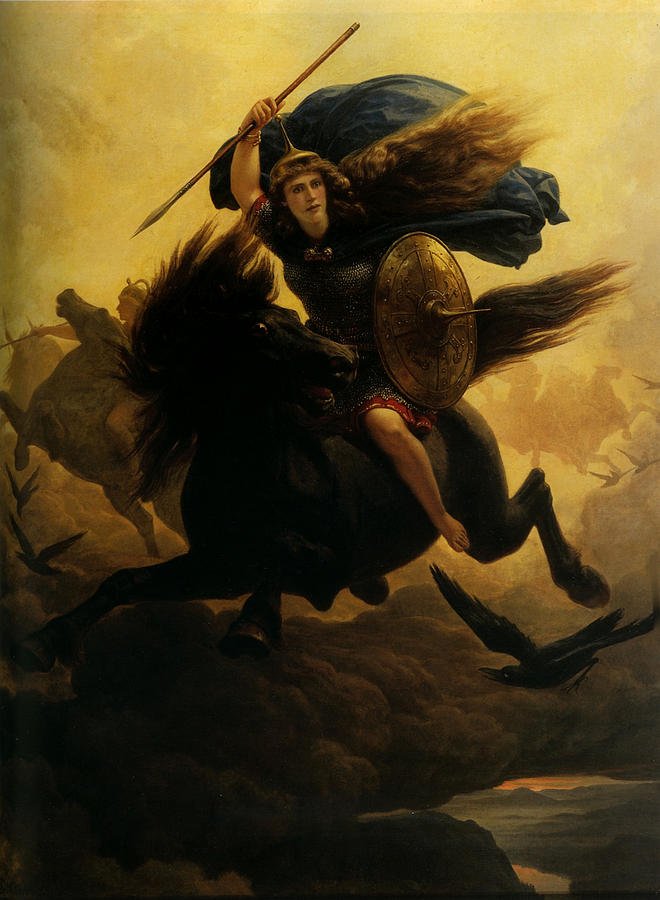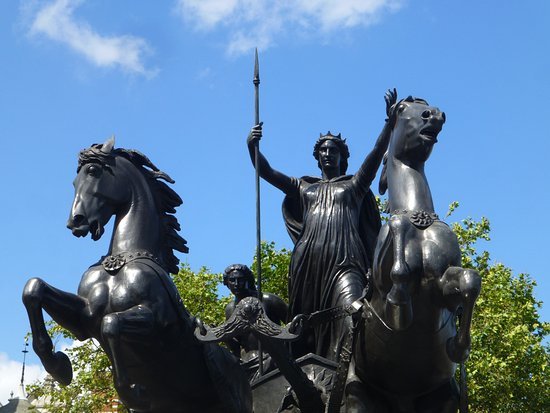Boudicca - The Woman, The Myth, The Legend (And The Historical Truths Hidden In Her Story)
By Emily Montague
You may have heard about Boudicca before, or at least seen her name somewhere (and likely struggled to pronounce it). Maybe you’ve seen artwork depicting the warrior-queen, her face painted blue and her red hair flying in a phantom wind.
But if you haven’t heard of Boudicca, her story goes like this. In the early part of the first century A.D., Rome was expanding its empire into the area now known as Great Britain. The people already living in this area had mixed opinions about the Roman incursion.
One tribe, the Iceni, had reluctantly agreed to become subjects of Rome in exchange for a nominal level of independence. Their chieftain, Prasutagus, paid his tax to the empire and kept the peace for many years. At the same time, the Roman nobility forced his people to take on loans and go into debt to the Emperor.
When the chieftain died, he left half his property to Rome and half to his wife Boudicca, and daughters. This was the way of his people––women were considered perfectly able to lead and rule as chiefs, nobles, and generally equal members of society. The Romans disagreed with this division. They wanted the whole of Prastagus’s property, including his rights and titles.
As one might expect of the Romans, they therefore ignored the chieftain’s legally binding will and seized all of his land, property, and titles. Boudicca challenged this decision and publicly spoke out against the Romans’ corruption and their complete breach of the trust placed in them by Prastagus.
She called into question the Romans’ honor and pointed out that, as per the written agreements signed by Rome and her late husband, her tribe was supposedly an independent ally of the Emperor and his senate. If they weren’t going to honor these contracts, why should the Iceni bother negotiating with them at all?
The Roman response was to imprison, torture, and sexually assault Boudicca and her two teenage daughters. The women were publicly flogged, their hair cut, and their dignity affronted before the entire Iceni tribe. Their entire household was put in chains and enslaved.
The Romans assumed that this would be the last they’d hear of Boudicca. The Romans were very, very wrong.
The Romans Get Iced–Boudicca Strikes Back, And Rome Immediately Regrets Its Life Choices
Upon recovering from her traumatic experience at Roman hands, Boudicca and her daughters did not disappear into the mists of history. They did quite the opposite.
Contrary to Roman beliefs, the Iceni and their neighbors were not a group of disorganized barbarian peasants. Nor was Boudicca a hysterical wife who didn’t know her place. She was, in the eyes of the Celts, a Queen.
She was about to demonstrate that fact in the most explicit fashion.
Boudicca gathered the Iceni and called upon their neighboring tribes. She showed her wounds to the horrified chiefs and their warriors, and her own men and women looked on in fury as she presented her battered daughters to the assembly. She demanded retribution––not only for her own sake or that of her daughters, but for that of all Celts.
Where, she demanded to know, was the so-called honor of the Roman Empire? Why should the Iceni tolerate the Roman presence at all? Clearly the Romans were savages, and the Celts had lost all sense of dignity if they tolerated this kind of behavior on their land.
Tall, red-haired, and powerfully built, Boudicca made a formidable warrior in her own right. Her presence was commanding, her voice harsh and resonant. When she spoke, the tribes listened.
Boudicca’s young daughters stood with her and provided visceral proof of everything she was saying. By the time she took up her spear and threw it into the frozen ground, every man in the crowd was already with her. They prepared for all-out war.
Meanwhile, the Roman governor Suetonius was out of office. He had chosen to go campaigning in modern-day Wales. The fact that he hadn’t bothered to stick around after his horrific attack on Boudicca and her household was proof of just how little a threat he and his officer’s assumed these women to be. This would prove to be one of the worst decisions of Suetonius’s career.
Queen Boudicca was an experienced strategist and a seasoned politician. Within a matter of weeks, she had assembled a fighting force of over 120,000 Celts and had established fortified supply lines to feed and arm them. Reinforcements were called in and a plan of attack was quickly drafted.
By the time Rome realized what was happening, Boudicca was already on the move. Roman nobles were choking on smoke before they realized their cities were on fire.
A Literal Feminist Inferno––Boudicca Puts The “Warrior” In Warrior-Queen
There’s a lot of dramatic flair in the stories Roman historians would eventually tell about Boudicca and her revolt. Considering the sheer scale of her initial victories, this was hardly necessary. Her character was dramatic enough without the addition of tall tales and magic.
PHOTO CREDIT: Peter Nicolai Arbo. Valkyrie. 1865, oil on canvas. Norwegian. via The Raven Report
The historian Tacitus based his accounts on the firsthand testimony of his father-in-law, who was a three-time member of the military Tribune that ruled the British Isles and witnessed the aftermath of Boudicca’s campaign in person. He described Boudicca as both fearsome and dignified, a woman who possessed a great love for her people and their Celtic way of life.
Like most Roman historians, Tacitus added his own speeches to Boudicca’s story. He gives her an edge of humility, and his version of Boudicca blames herself for not expelling the Roman occupiers sooner. She tells the Celts that there is no point in living as slaves, as none of their wealth, land, or rights matter if the Romans control how that wealth, land, and right to rule are exercised.
Realistically, the Iceni had once been willing allies of the Roman empire. The Celtic tribes were not always on friendly terms and had periodically sided against each other, some with Rome and some against them. Allying with the Romans was a political decision Boudicca and her husband had made because it was practical at the time. The issue wasn’t that they had allowed Roman influence to exist in the region––that was a foregone conclusion by the time Boudicca was born––but that the Romans had reneged on their promises and betrayed the very allies they had once courted.
There’s an old saying that “hell hath no fury like a woman scorned,” but the point is equally valid when talking about political allies. Betray an ally, and they’ll be a worse enemy than any mere rival. To reduce Boudicca’s campaign to an act of personal revenge is not only dishonest, but it also reduces the very real political power that she held amongst her people.
In a sense, the assault on Boudicca, her daughters, and her household was as much a symbolic act as it was a physical one. It was both personal and political, and it’s foolish to believe that one woman’s personal need for vengeance could motivate 120,000 warriors to risk their lives and property. If anything, Boudicca was simply expressing the pain and fury of the entire Celtic culture when she refused to take her abuse sitting down. Enough was enough.
Her army gathered and her authority secured, Boudicca advanced on the Roman colonia of Camulodunum (now known as Colchester). The settlement was mostly occupied by retired Roman soldiers, some of whom had been guilty of committing the same abuses as those inflicted on Boudicca and her household. She and her army burned the colony to the ground. There were no known survivors.
Next on the hit list was Londinium, the town that would one day be known as London. Boudicca led the assault herself, as was her habit. She is reported to have been skilled with a javelin and was known for being an excellent chariot driver. With a golden torque at her neck, a circlet on her head, and a face painted in the style of the Iceni warriors, she would have been terrifying to behold.
Londinium was abandoned to its fate, and little was left of it once Boudicca and her men were finished. Once the looting and burning was done, they moved on to their third and final target: the settlement now known as St. Albans. Once again, the town was razed by Boudicca and her armies.
The warrior-queen had made her point and provided Rome with an extremely poignant reminder of their responsibility to ensure peace, justice, and goodwill between nations.
More importantly, she’d demonstrated exactly what would happen if they failed to do so in the future.
A Blaze Of Glory––A Tragic End To Queen Boudicca’s Story
History isn’t always as straightforward as we’d like it to be. Truthfully, Boudicca was neither a hero nor a villain by our modern standards, and her figure has been mythologized, demonized, and distorted many times over the centuries following her revolt.
When all was said and done, Boudicca’s army had killed over 70,000 people in Londinium, Camulodunum, and St. Albans. Many of these people were civilians, and they included men, women, and children. The Romans had done as much or far worse to the Celtic tribes over the years, and some have argued that this was simply the marker of violent times in a harsh and violent place.
Statue by Thomas Thornycroft, Westminster Bridge, London via Trip Advisor
Regardless of the morality behind Boudicca’s revolt (or the lack thereof), it did not last. After the razing of St. Albans, the Roman army rallied and received a large number of reinforcements from the continent. Boudicca’s army made a last stand but was ultimately defeated by Suetonius and his legions. The Romans slaughtered every man, woman, child, and animal that accompanied the Iceni tribes––an act of brutality that was barbaric even by Imperial standards.
Some historians have argued that part of the reason the Romans hated Boudicca so fiercely was her gender. Rome was a decidedly patriarchal culture at that time, and it would have been extremely embarrassing for them to have been thoroughly routed by a woman-led army like Boudicca’s. It was especially shameful when that woman had been allegedly “shamed into submission” by those same supposedly manly and virile Romans.
Boudicca was an affront to everything Rome believed about itself, and her legacy has depicted her more as a heroic, almost goddess-like figure than a villainous one. Even later Romans held her up as a paean of liberty and national pride. She was acknowledged to be a brilliant tactician, a formidable warrior, and a chieftain worthy of being called the “Queen of the Celts” millennia after her death.
No one knows precisely how Boudicca died. It’s generally agreed that she perished during that final battle with Suetonius, but her grave––likely a barrow, if her body was recovered by the remaining Iceni––has never been found. Some academics have even argued that she never existed in the first place, but was instead a stand-in for several figures involved in the various revolts that happened during the Roman occupation of Britain.
Most historians agree that she was very much real, however, and there is too much evidence regarding her actions as a leader to truly contest this view. Roman sources state that Boudicca committed suicide after the battle with Suetonius, possibly to avoid capture and humiliation in Rome. Other sources say that she died in battle, or of an injury and subsequent infection following it.
Regardless of how she died, Boudicca has been immortalized in art, poetry, and the annals of Roman and British history. Her legacy is a powerful one, especially for the brave women who have stood up for their rights and dignity in the U.K. and beyond. Her name has been a rallying cry for the Irish and an inspiration for modern women and girls all over the globe.
Suetonius and the Romans may have taken her property and ultimately her life, but Boudicca’s story lives on. To paraphrase one of the many sayings of the people who once occupied her isle: “A great hero may fall, but they do not die until their name is spoken for the last time.”
And so in many ways, the enigmatic Boudicca is still very much alive.
THIS ARTICLE WAS MADE POSSIBLE BY THE GENEROUS SUPPORT OF OUR PARTNERS. A HUGE THANK YOU TO LALIT AND SHUBHA VADLAMANI FOR EMPOWERING US SO WE CAN EMPOWER WOMEN!
The views, thoughts, and opinions expressed in this article belong solely to the author, and do not necessarily reflect the position of The Fem Word organization. Any content provided by the author are based on their opinions and are not intended to malign any religion, ethnic group, club, organization, company, individual or anyone or anything.



